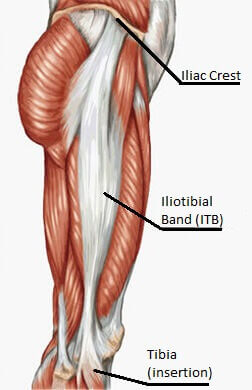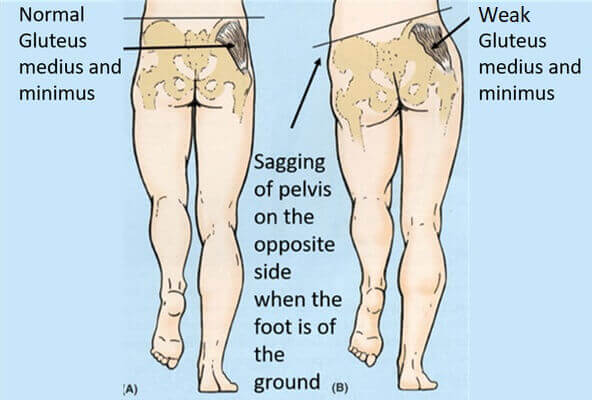I have knee pain when I run! How do I stretch my ITB (Iliotibial band)?
If you are a runner or a cyclist or even both, at some point, you may become aware of a gradually more noticeable pain on the outside of the knee. It’s possible that you’re developing a Runner’s knee or technically an Iliotibial Band (ITB) friction syndrome.

What is Iliotibial Band (ITB)?
Let’s start with some anatomy: The ITB is a band that connects the iliac crest to the Gerdy’s tubercule, in the tibia (Figure 1). This band is very thick and strong and acts as a “strong rope” or “strong leather band”, like a belt that is tensioned by two muscles: Tensor Fascia Latae (TFL) and by the Gluteus Maximus (Buttock Muscle).
Functions of Iliotibial Band (ITB)
Looking at the mechanics, the main function of this complex that comprehends the gluteus maximus+TFL+ITB is to help the gluteus medius and minimus stabilise the pelvis in single leg stance in more dynamic activities (Figure 2) such as walking or running. You see, when you run, at some point, one of your legs is in the stance phase, the other one is on the swing phase. In simple terms, the leg on the stance phase will be responsible for keeping you balanced on it as you move through significant speed. This ITB complex will play an important role on this action.
What are the possible causes of Runner’s Knee
So, as important actors, the muscles, especially the Tensor Fascia Latae (TFL), may get overloaded or tight for different reasons:
- Weak gluteus medius and minimus.
- Previous/current problem on other area of the leg or on the opposite lower limb.
- Poor or nonexistent stretching programme along side running/cycling activity.
- Sudden and significant increase in mileage, gradient, pace.
- Old or inappropriate choice of footwear.
- Lower back stiffness.
- Office based job
This will increase the tone of the muscle increasing the tension through the ITB even in resting or reduced activity periods.

Along its way from the iliac crest to the tibia, the ITB crosses over some edges that are more prominent on the outside of the knee. If these prominences are not a problem when the ITB is normally tensioned by the TFL, it is often a different story when the TFL is tight, making this band friction on these prominences, getting it inflamed and leading to this runner’s knee condition.
Can we really stretch the ITB?
-
A study by Wilhelm2 et al (2016) in which the TFL+ITB complex was removed and stretched in a mechanical device suggests the main contributor to the lengthening of the TFL+ITB complex is the TFL as, on their study, the component of the ITB that includes the TFL is the one that allows more significant stretch (3.96 mm) when compared with the other 2 parts (2.25mm and 2.12mm), but it still didn’t go beyond an overall stretch of only 2.5% of its total length!
-
Another study by Falvey3 et al (2009), suggests the magnitude of a stretched imposed to the ITB whilst still in place, doesn’t go beyond 0.2% of its length (!), suggesting the apparent stretch of this structure is very likely due to the lengthening effect the stretch has on the TFL.
Seeing a physiotherapist will assure that the cause of the problem is addressed, that you won’t be harming other joints that may have some previous history of pain and that other diagnoses that may give you similar symptoms are ruled out.
So, what exercises help to address tightness of the Tensor Fascia Latae (TFL)?
However depending on the cause of the problem this may not be a permanent solution. We’ll be scrutinising these exercises and explain why they may be helpful on our next posts on Instagram/Facebook:
References:
- Powers CM. The influence of abnormal hip mechanics on knee injury: a biomechanical perspective. J Orthop Sports Phys Ther 2010;40:42–51.
- Wilhelm M, Matthijs O, Browne K, et al. Deformation response of the iliotibial band-tensor fascia lata complex to clinical-grade longitudinal tension loading in-vitro. Int J Sports Phys Ther. 2017;12(1):16-24.
- Falvey EC, Clark RA, Franklyn-Miller A, Bryant AL, Briggs C, McCrory PR. Iliotibial band syndrome: An examination of the evidence behind a number of treatment options. Scand J Med Sci Sports. 2010;20(4):580-587.
